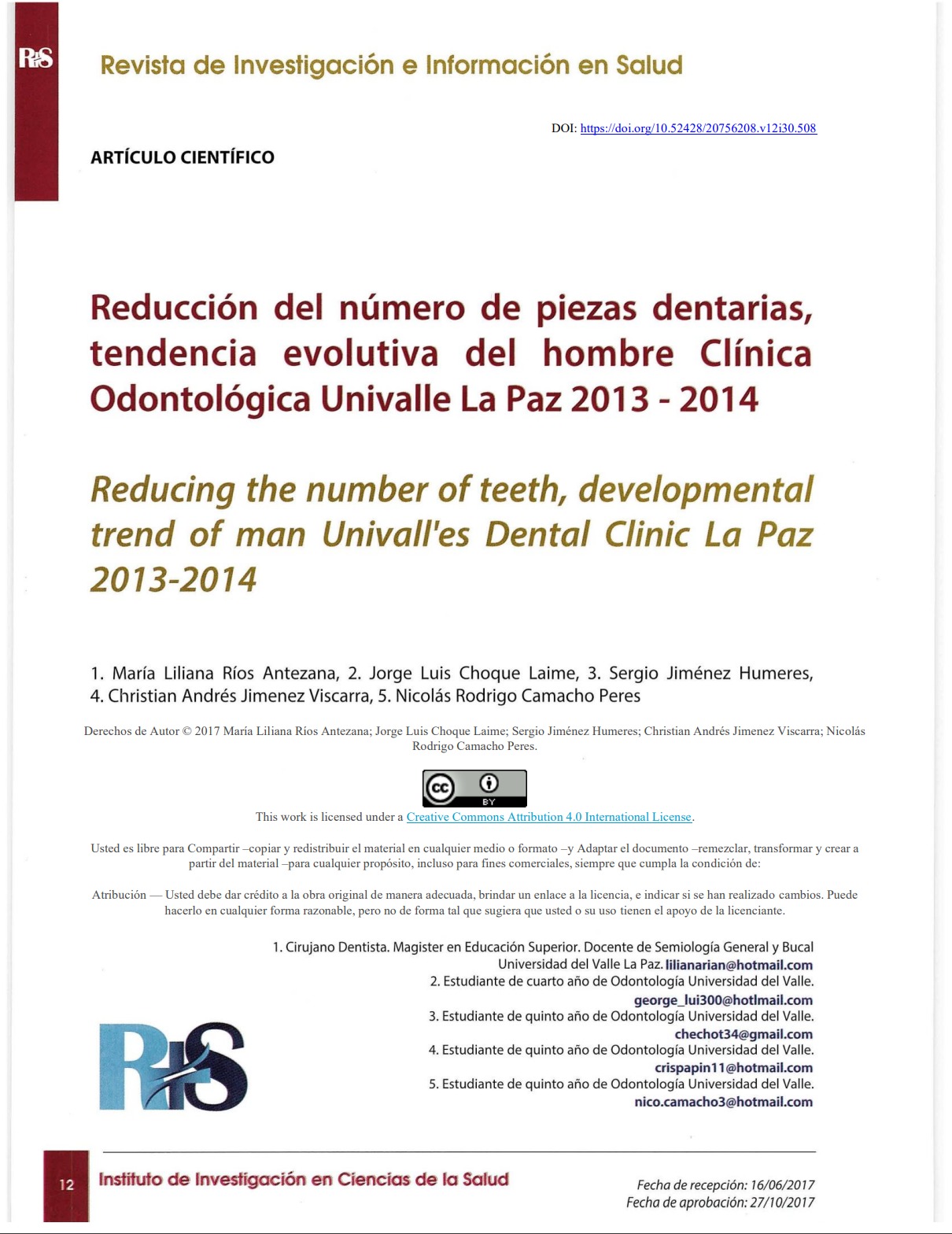Reducing the number of teeth, developmental trend of man Univall'es Dental Clinic La Paz 2013-2074
DOI:
https://doi.org/10.52428/20756208.v12i30.508Keywords:
Dental evolution, Dental agenesis, Dental systemAbstract
Tooth agenesis is used to designate the congenital absence ofone or more dental pieces, due to a disturbance in the stages ofinitiation or early morphogenesis ofthe same. A research was carried out with the aim ofproposing the existence ofa type ofdental evolution that takes place day by day and that can be presented in our environment. This is a cross-sectional descriptive study taking into account as a universe of 1000 patients, presenting 76 patients with Agenesia that would be the study population, between 12-45 years of both sexes, Wilcoxon statistical treatment was performed as a test ofreliability ofthe 95% and with a significance value of 0.05 (P <0.05). The results found are: Tooth agenesis is greater in the female sex in 66% (50 patients), 58% (44 patients) of higher prevalence in the upper jaw, 61% (46 patients) more in the left hemiarch and the dental group with greater agenesis is that of the molars in 88% (67 patients). With the disadvantage that Other alterations (size, retention, shape) and the possibility of reducing the presence of some pathology (retention of teeth, cysts or tumors) may occur in the future. lt is concluded that there is a regression in the number ofdental pieces and that in the first instance the agenesis ofthe third molars Will be presented followed by the premolars; obtaining the following: I 1/2 C 1/1 P 1/2 M 2/2.
Downloads
References
NORALANE M LINDOR. Colorectal cancer and self-reported tooth agenesis. 2014, USA. http://www.hccpjournal.com/content/pdf/1897-4287-12-7.pdf (6 de julio de 2014).
FRANCISCO JAVIER KOLENC FUSÉ. Agenesias dentarias: en busca de las alteraciones genéticas responsables de la falta de desarrollo. Octubre del 2003. http://scielo.isciii.es/pdf/medicor/v9n5/03.pdf (6 de julio de 2014).
PATRICIA PINEDA. Prevalencia de Agenesia Dental en Niños con Dentición Mixta de las Clínicas Odontológicas Docente Asistencial de la Universidad de La Frontera. 201 1, Temuco, Chile. http://www.scielo.cl/pdf/ijmorphol/v29n4/art02.pdf (6 de julio de 2014).
DRA. MARIA ELENA LABAJO GONZALES. Desarrollo y evolución dental: del pez al hombre. Agosto del 2005. http://www.coem.org.es/sites/default/files/revista/cientifica/v012-n2/desarrollo.pdf (28 de Julio de 2014).
PROFA. DRA. M a ROSA MOURELLE MARTÍNEZ. Maduración y desarrollo dental de los dientes permanentes en niños de la comunidad de Madrid. aplicación a la estimación de la edad dentaria. 201 1, Madrid.
http://eprints.ucm.es/19916/1 /Marta_Paz_Cort%C3%A9s-trabajo_de_investigaci%C3%B3n..pdf (28 de julio de 2014).
PEDRO SARMIENTO. Agenesia de terceros molares en estudiantes de odontologia de la Universidad del Valle entre 16 y 25 años. 2004. http://www.redalyc.org/pdf/283/28335902.pdf (28 de julio de 2014).
DR. GONZÁLEZ-GONZÁLEZ, J.M. Agenesia dental de los cuatro segundos premolares. Presentación de un caso inusual. 1998. http://www.uv.es/pascuala/ejdr/Art00013.htm (28 de julio de 2014).
DRA. BELKIS CORREA MOZO. Agenesia dentaria : Estudio Familiar. 1996, Cuba. http://bvs.sld.cu/revistas/ord/voll 1_I_96/ord05196.htm (28 de julio de 2014).
DR OSCAR J. QUIRÓS Y DR. AURISTHELA PALMA. El Tercer Molar Mandibular, Método Predictivo de Erupción. http://www.actaodontologica.com/oscar_quiros/tercer_molar_mandibular.asp (28 de julio de 2014).
Leyes de Mendel. http://www.quimicaweb.net/web-alumnos/GENETlCA%20Y%20HERENClA/Paginas/5.htm (28 de julio de 2014).
Primera de Mendel o la segregación (Monohibridismo). http://www.blogdebiologia.com/2014/02/1eyes-de-mendel.html#.U-gim_150So (28 de julio de 2014).
Patología en el número de dientes. Anodoncia http://saludabilis.com/patologias-en-el-numero-de-dientes/. (28 de julio de 2014).

Downloads
Published
How to Cite
Issue
Section
License
Copyright (c) 2017 María Liliana Ríos Antezana, Jorge Luis Choque Laime, Sergio Jiménez Humeres, Christian Andrés Jimenez Viscarra y Nicolás Rodrigo Camacho Peres

This work is licensed under a Creative Commons Attribution 4.0 International License.
Authors who publish with this journal agree to the following terms:
- Authors retain copyright and grant the journal right of first publication with the work simultaneously licensed under a Creative Commons Attribution License 4.0 that allows others to share the work with an acknowledgement of the work's authorship and initial publication in this journal.
- Authors are able to enter into separate, additional contractual arrangements for the non-exclusive distribution of the journal's published version of the work (e.g., post it to an institutional repository or publish it in a book), with an acknowledgement of its initial publication in this journal.
- Authors are permitted and encouraged to post their work online (e.g., in institutional repositories or on their website) prior to and during the submission process, as it can lead to productive exchanges, as well as earlier and greater citation of published work.






















